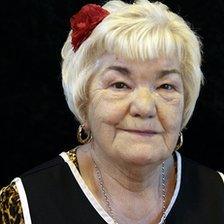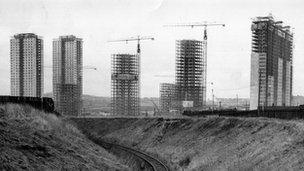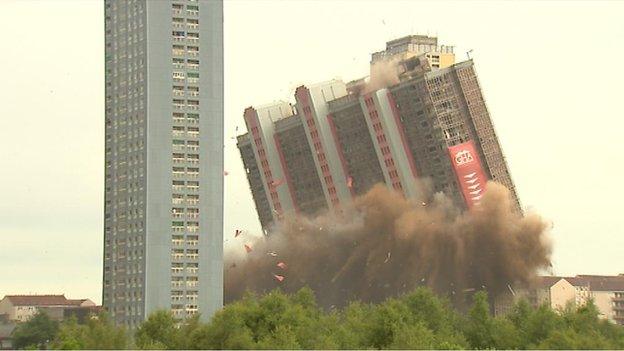The end of Glasgow's Red Road housing estate
- Published
BBC Newsnight's Catrin Nye looks at the life of the epic structures
As the first of the Red Road tower blocks in Glasgow are demolished, former residents have been remembering what life was like in the epic structures.
Approaching Red Road by car, the buildings loom into view - intimidating as much as they are awe-inspiring.
These towers were built as the solution to a post-war housing crisis, the ultimate in modern communal living.
And for a time they lived up to the promise.
But quickly Red Road came to embody everything that was wrong with high-rise living - symbols of alienation and poverty, the very problems from which they were designed to provide an escape.
Initially, the plans for the eight buildings were fairly modest, but by the time they were completed in 1969 they had become something of an architectural experiment.
They were the highest residential blocks in Europe and provided homes to almost 5,000 people. They have inspired a film, a novel, and fascinated photographers and artists.
So what was it like as an inhabitant of the estate?
Jean McGeough - the first resident
As one of Red Road's earliest residents Jean McGeough, initially at least, saw the towers at their best. Her new home meant a vast improvement in living conditions. She tells the now famous local story of being handed a ticket with her floor and house number on it.

Jean McGeough enjoyed the community spirit
"We got up to here with my friend and I'm like, we're gonna be late, we're gonna be late," says Jean.
"And my friend went 'look at the crowds, are they all getting houses up here?' - but it was people taking pictures as well as new residents. I had a wee card and they told us to pick for a house and I had my neighbour with me and said 'you pick it for me,' and she said 'no you pick it' - so I did. I got 9-3 and I was very, very happy."
For Ms McGeough the flats meant community. She shared cleaning the hallways on a rota system with her neighbours and children would run through her flat to get to the only stairs in the building when the lifts failed.
She went to The Brigg, the famous thousand-seater Bingo hall that was built under the flats and she worked in the bar at Red Road. She concedes it did not last, but for a time, they were everything.
"They were lovely the houses and it's breaking my heart to see them coming down."
Azam Khan and Peter McDonald - darker times
By the time Azam Khan and Peter McDonald lived in Red Road in the late 1980s and early 1990s, Red Road had a very different kind of community.
The first block was demolished in June 2012
It was no longer a desirable place to live. They describe it as a "dumping ground" and Mr Khan's new neighbours robbed for a living.
"A black cab dropped us off at the back of the building," he says. "And when you get out and see this big huge monster building in front of you and you're like 'is this it?'"
The new home that greeted Mr Khan was coated wall-to-wall in pigeon excrement and he was quickly introduced to the story of the previous occupants.
"The two residents beforehand had both jumped out the kitchen window, so when you looked out the window you could see where they'd landed because that's where it had been patched up."
"It was very rough, drugs took over the place. There was a lot of unemployment. They were closing down the shipyards, there were no jobs about and crime seemed to be the best way to pay for things. It was hard times."
"If you were a single guy and you put your name down for a flat you probably got shoved here," says Mr McDonald.
"That was just the way it was, a dumping ground. Look at them - they just look rotten don't they? Big gravestones."
Both men say they learned a lot at the flats and that they toughened them up at least.
Mohsin Ali - the asylum seeker
The horror stories of Azam Khan and Peter McDonald could have been the end of the story for Red Road and in fact for many they were.

The estate was originally built to create communities
But there was to be another wave of residents to come. As well as council tenants, the flats were in turn used to house students and finally became a home for asylum seekers. Red Road briefly shot to fame again when a family of Russians jumped to their deaths in 2010.
But amid the despair was a final wave of hope.
For Mohsin Ali and his family the flats provided security and in fact echoed their original purpose - a place that inspires awe and creates communities. Mr Ali was a police officer back home in Faisalabad, Pakistan and he has been in Scotland seeking asylum since 2007.
"We were afraid when we arrived here - going higher and higher, it's just like being in a plane," says Mr Ali. "But after that we saw many families like ours and we thought we were lucky to be here. I like the Red Road flats and so do my children. The only thing was that when the wind blows, the flats would move."
Mohsin Ali talks of not having to leave the building to see his new friends. For many that would mean feeling trapped, but for him it was safety.
"The children feel very secure here, especially when we arrived because we were threatened in Pakistan.
"My children are now integrated and are used to it here and have friends. They cannot go back. My younger daughter was born here, she was born in the Red Road flats - she is Glaswegian - we've got a Red Road baby."
Watch Catrin Nye's full report on BBC Newsnight on Monday 11 June at 22:35 BST on BBC Two.
- Published10 June 2012

- Published29 June 2010